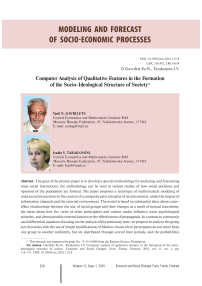Computer analysis of qualitative features in the formation of the socio-ideological structure of society
Автор: Gavrilets Yurii N., Tarakanova Iraida V.
Журнал: Economic and Social Changes: Facts, Trends, Forecast @volnc-esc-en
Рубрика: Modeling and forecast of socio-economic processes
Статья в выпуске: 1 (55) т.11, 2018 года.
Бесплатный доступ
The goal of the present paper is to develop a special methodology for analyzing and forecasting mass social interactions; the methodology can be used in various studies of how social positions and opinions of the population are formed. The paper proposes a technique of mathematical modeling of mass social interactions in the context of a comprehensive interplay of social contacts, under the impact of information channels and the external environment. The model is based on substantial ideas about cause-effect relationships between the size of social groups and their changes as a result of mutual transitions, the ideas about how the views of other participants and various media influence socio-psychological attitudes, and about possible external impact on the effectiveness of propaganda. In contrast to commonly used differential equations focusing on the analysis of the stationary state, we propose to analyze the group size dynamics with the use of simple modifications of Markov chains when participants do not move from one group to another uniformly, but are distributed through several time periods, and the probabilities of such a transition depend on the current state...
Attitude, ideological structure of society, social groups, social contacts, media, dynamics, probability of inter-group transitions
Короткий адрес: https://sciup.org/147224013
IDR: 147224013 | УДК: 316.452 | DOI: 10.15838/esc.2018.1.55.8
Список литературы Computer analysis of qualitative features in the formation of the socio-ideological structure of society
- Shvedovskii V.A. Simulation of information dissemination in adjacent social groups. In: Matematicheskie metody v sotsiologicheskom issledovanii . Moscow: Nauka, 1981. pp. 207-214..
- Isea R., Mayo-García R. Mathematical analysis of the spreading of a rumor among different subgroups of spreaders. In: Pure and Applied Mathematics Letters. 2015. Pp. 50-54.
- Nekovee M., Moreno Y., Bianconi G., Marsili M. Theory of rumor spreading in complex social networks. Physica A. 2007, no. 374, pp. 457-470.
- Thompson K., Castro Estrada R., Cinstron-Arias A. Deterministic approach to the spread of rumors. Washington DC, 2003.
- Turchin P. Secular cycles. Princeton University Press, 2009.
- Sieff M. Major challenges face Central Asia in 2011. Central Asia News-wire, 2010 Jan 30. Available at: http://centralasianewswire.com.
- Dolgaeva E.I., Krylova VV. The claims of the population to the government: what remains beyond the quantitative measurements. Sotsiologicheskie issledovaniya=Sociological studies, 2015, no. 7, pp. 58-64..
- Malkov A.S. Processes in modernizing societies and the cycles of instability. In: Sbornik "Arabskaya vesna 2011" . Moscow: Izd. LKI, 2011. Pp. 440-460..
- Malkov S.Yu. Mathematical simulation of historical dynamics: approaches and models. In: Modelirovanie sotsial’no-politicheskoi i ekonomicheskoi dinamiki . Moscow: RGSU, 2004. Pp. 76-188..
- Khodunov Yu.V., Zin’kina A.S., Karataev A.V. Forecasting socio-political instability. In: Sbornik "Arabskaya vesna 2011" . Moscow: Izd. LKI, 2011. Pp. 384-434..
- Zolo D. Demokratiya i slozhnost’: realisticheskii podkhod . Moscow: Izd. dom GU-VShE, 2010.
- Luhmann N. Real’nost’ massmedia . Moscow: Praksis, 2005.
- Gubanov D.A., Novikov D.A., Chkhartishvili A.G. Sotsial’nye seti: modeli informatsionnogo vliyaniya, upravleniya i protivoborstva . Moscow: Fizmatlit, 2010.
- Walton B. Creating Europe: the discourse of civilization. Interstate Journal of International Affairs, 2013/2014, no. 1, pp. 1/1.
- Rashevskii N. Two models: imitative behavior and the distribution of the status. In: Matematicheskie metody sovremennoi burzhuaznoi sotsiologii . Moscow: Mir, 1966..
- Mikhailov A.P., Petrov A.P., Marevtseva N.A., Tret’yakova I.V. Development of the model of information dissemination in society. Matematicheskoe modelirovanie=Mathematical modeling, 2014, no. 26 (3), pp. 65-74.
- Proncheva O.G. Effect of social polarization on the outcome of information warfare. Preprinty IPM im. M. V.Keldysha=Keldysh Institute preprints . 2016. No. 75. Available from: http://keldysh.ru/papers/2016/prep2016_75.pdf.
- Gavrilets Yu.N., Klimenko K.V., Kudrov A.V. Statistical analysis of social tension factors in Russia. Ekonomika i matematicheskie metody=Economics and mathematical methods, 2016, no. 52 (1), pp. 45-66..
- Pfanzagl J. Teoriya izmerenii . Moscow: "Mir", 1976.
- Gavrilets Yu.N., Fomina Yu.V. Modeling the dynamics of social attitudes (attitude toward commercial advertising on television). Sotsiologiya: metodologiya, metody, matematicheskoe modelirovanie=Sociology: methodology, methods, mathematical modeling, 2002, no. 15, pp. 110-134..
- Gavrilets Yu.N., Chekmareva E.A. Modeling of equilibrium operation of economy in the North-West Federal District. Ekonomicheskie i sotsial’nye peremeny: fakty, tendentsii, prognoz=Economic and social changes: facts, trends, forecast, 2010, no. 4, pp. 107-118.
- Makarov V.L., Bakhtizin A.R., Bakhtizina N.V. CGE model’ sotsial’no-ekonomicheskoi sistemy Rossii so vstroennymi neironnymi setyami . Moscow: TsEMI RAN, 2005. Available at: www.abm.center
- Gorskii D.P. Synthesis and cognition. RZh INION AN SSSR=Abstracts journal of the Institute of Scientific Information on Social Sciences (INION) of the Academy of Sciences of the USSR. 1986..
- Rose M. Why are gender relations important to include in study of politics and society? Interstate journal of international affairs, 2015/2016, no. 1, pp. 1-2.
- Jung C.G. Psikhologicheskie tipy . OOO "Popurri", 1998.


